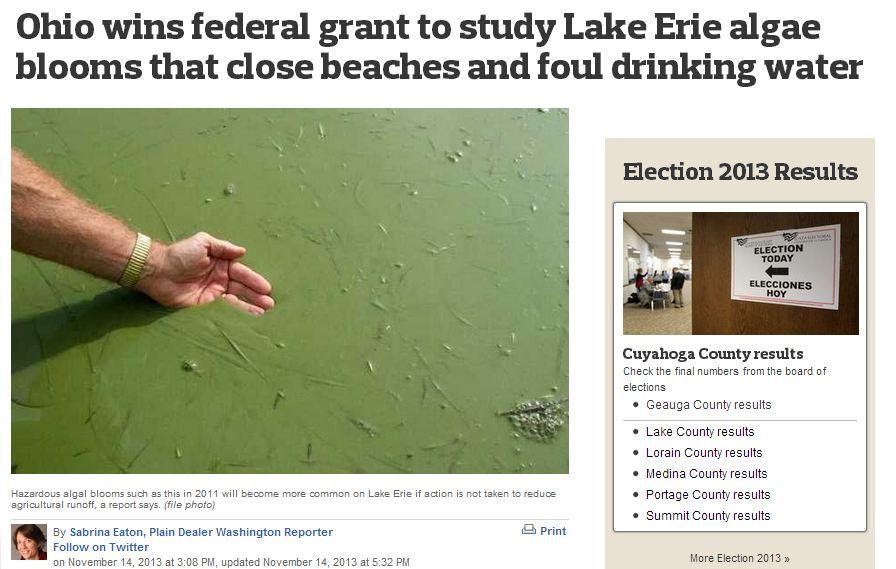While planet Earth is 70% water, nearly all of it is undrinkable salt water. The planet’s potable supply is either frozen in polar ice caps or dwells underfoot as groundwater. As such, the only freely accessible sources of fresh water are rivers and lakes. So, when Ohio’s Lake Erie was plagued by algal blooms two years ago, residents and local authorities were understandably concerned. Just this November, a grant was given to a group of Ohio universities and the Ohio Lake Erie Commission to determine the cause of this ecological emergency:
A consortium of four Ohio universities and the Ohio Lake Erie Commission were awarded a $500,000 U.S. Environmental Protection Agency grant this week to study the causes of harmful algae blooms that have closed Lake Erie’s beaches, affected its drinking water, and contributed to low oxygen areas where fish can’t survive.
 The grant will be used to examine the role nutrients like phosphorous play in the growth of the gooey green gobs that multiplied so vigorously in 2011 that they covered almost a fifth of Lake Erie’s surface, gumming up boat motors and closing beaches.
The grant will be used to examine the role nutrients like phosphorous play in the growth of the gooey green gobs that multiplied so vigorously in 2011 that they covered almost a fifth of Lake Erie’s surface, gumming up boat motors and closing beaches.
As mentioned in the article, the presence of excessive nutrients in the water can trigger the rapid growth of algae. More specifically, when the runoff from fertilized agricultural land, river beds, or land clearings reaches a lake, the excess phosphorus and nitrogen it carries can enrich the water (called eutrophication) and make it a breeding ground for harmful blue-green algae. Other conditions like warm weather, abundant sunlight, and slow water flow can further encourage algal blooms.
The main problem with runoff is that it is untreated, meaning all the nutrients it possesses are fed directly into water bodies. For this reason, many municipalities install stormwater systems as a best management practice when it comes to dealing with runoff. For example, Hydrologic’s StormChamber system function as underground water containers where rain and flood water can drain into, thus preventing run off. It has a special system that traps sediments, which act as carriers of nutrients like phosphorus. Whatever nutrient or pollutant is left behind will be decomposed by the naturally occurring micro-organisms in the stone and soil layer beneath the StormChamber.
Lakes provide people with water, food, recreation, and a source of tourism, and caring for them should be of utmost importance. Fortunately, storm water systems protect lakes and other bodies of water from the havoc that algal blooms can bring.
(Article Excerpt and Image from Ohio wins federal grant to study Lake Erie algae blooms that close beaches and foul drinking water, Cleveland.com, 14 November 2013)





